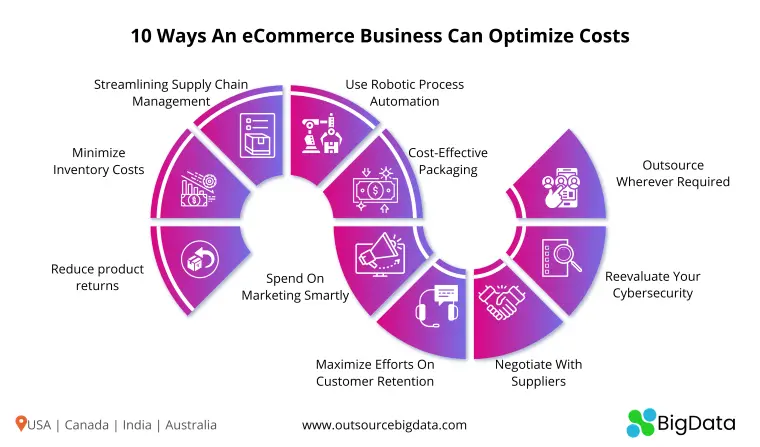10 Ways to Optimize Cost in
eCommerce Business in 2024
10 Ways to Optimize Cost in eCommerce Business in 2024
Author : Jyothish
AIMLEAP Automation Works Startups | Digital | Innovation | Transformation

Table of Contents
Global retail eCommerce sales were estimated to be over 4.9 trillion dollars in 2021. This value is expected to increase by 50%, reaching $7.4 trillion by 2025.
Due to lockdowns, store closures, and other limitations, eCommerce activity has increased dramatically in the last two years, as the pandemic has forced more of us to discover alternate ways to explore and buy. This has accelerated the already-increasing trend toward online shopping, which now appears to be beneficial for eCommerce businesses. With new corona variants triggering further breakouts, there is a rising fear of physical touch and due to this online shopping business will grow.
More than 2 billion people throughout the world buy products online. The number of active online purchasers worldwide was estimated to be approximately 2.14 billion in 2021. To put it in context, it’s more than a quarter (27.6%) of the world’s population of 7.74 billion people.
Today, eCommerce is a big business with great market potential but many risks and complexities are involved. It is a different game than conventional retail, and it’s also fairly complicated. Mid-sized brands and retailers frequently encounter obstacles in developing and operating an eCommerce business, since it necessitates specialized technical and operational skills, market understanding as well as more flexible, rapid decision-making.
Profit margin, Sales volume are the things that come to your mind when thinking about growing your eCommerce business. However, for sustainable growth, it is important to carry out your business activities in the most cost-efficient way, right from production to consumption. For an eCommerce business, growth can be achieved by optimizing the costs (expenses) and by increasing the returns on investments. In this article, we will focus on the former part, i.e. optimizing or reducing your business’s operational costs. There are companies offering eCommerce management services that you can leverage to build your eCommerce business and take it to the next level of success. Making the use of advanced technology and strategies, expert eCommerce can not just keep your business managed, but also optimize cost. Here are the 10 ways an eCommerce business can optimize costs.
Global retail eCommerce sales were estimated to be over 4.9 trillion dollars in 2021. This value is expected to increase by 50%, reaching $7.4 trillion by 2025.
Due to lockdowns, store closures, and other limitations, eCommerce activity has increased dramatically in the last two years, as the pandemic has forced more of us to discover alternate ways to explore and buy. This has accelerated the already-increasing trend toward online shopping, which now appears to be beneficial for eCommerce businesses. With new corona variants triggering further breakouts, there is a rising fear of physical touch and due to this online shopping business will grow.
More than 2 billion people throughout the world buy products online. The number of active online purchasers worldwide was estimated to be approximately 2.14 billion in 2021. To put it in context, it’s more than a quarter (27.6%) of the world’s population of 7.74 billion people.
Today, eCommerce is a big business with great market potential but many risks and complexities are involved. It is a different game than conventional retail, and it’s also fairly complicated. Mid-sized brands and retailers frequently encounter obstacles in developing and operating an eCommerce business, since it necessitates specialized technical and operational skills, market understanding as well as more flexible, rapid decision-making.
Profit margin, Sales volume are the things that come to your mind when thinking about growing your eCommerce business. However, for sustainable growth, it is important to carry out your business activities in the most cost-efficient way, right from production to consumption. For an eCommerce business, growth can be achieved by optimizing the costs (expenses) and by increasing the returns on investments. In this article, we will focus on the former part, i.e. optimizing or reducing your business’s operational costs. There are companies offering eCommerce management services that you can leverage to build your eCommerce business and take it to the next level of success. Making the use of advanced technology and strategies, expert eCommerce can not just keep your business managed, but also optimize cost. Here are the 10 ways an eCommerce business can optimize costs.
10 Ways An eCommerce Business Can Optimize Costs
Optimizing your costs as per the current market standards is advantageous because it allows you to keep your business healthy, self-regulating, and expanding without worrying about losing consumers to the competition. The crucial question is how to reduce your eCommerce company’s overhead costs while keeping product costs low and increasing business profitability. True optimization necessitates a comprehensive approach that connects activities and multiplies efficiency advantages. One of the best ways to optimize costs is obtaining eCommerce management services from experts and reducing your dilemma of the management of your eCommerce business. A service provider can handle your end-to-end eCommerce operation by leveraging advanced tools, technologies and expertise while you focus on your core business. If you are not sure where to begin, here are the top 10 ways that you can follow to optimize costs.

1. Reduce product returns
Did you know that at least 30% of all things bought online are returned, compared to only 8.89% in physical stores?
The most common reasons behind the product return is poor quality, wrong product descriptions, colour differences, and late delivery. Sometimes businesses don’t deliver what they promised which forces the buyer to return the product. If your return rate is less than 30%, thank your fortunate stars since you’re doing well. If your rate is more than 30%, there is obviously some work to be done to lower it. When the customers return a product, from shipping to packaging cost, it’s you who bear everything. So, returns are a major headache for an eCommerce business. To decrease returns, make sure to list your products properly. Share high-quality images and videos, focus on detail-rich product descriptions, implement size guides, prioritize packaging and promote exchanges instead of returns. There are many buyers who return a large number of things at once and benefit from a flexible return policy. Serial returners may cost businesses thousands of dollars because they utilize an item once, such as clothing and jewellery and then return it for a full refund.
According to research, 30% of customers purposefully overbuy things because they know they can simply return them for a full refund.
Keep an eye on a customer with the habit of returning products. With enough information, you can send a warning or even temporarily block their account to prevent them from purchasing from you and increasing your return percentage. If the process seems complicated, you can outsource eCommerce management services from certified professionals. They have the expertise to manage your eCommerce product account in a way that reduces product returns.
2. Minimize Inventory Costs
Reducing your inventory cost actually helps you make more money. Controlling costs hasn’t always been at the top of the priority list in the ever-changing eCommerce world because the competition was mild in the past and businesses were able to keep a consistent amount of inventory. Now more competitors are arriving in the market with new and better products at a competitive price and it is causing a problem for a lot of old sharks of the eCommerce business. We know the costs involved in warehousing and fulfillment of products is significant. But you need to reduce your inventory cost in order to sell the less popular or less bought items with high competition in the market. Eliminating excess products from the inventory can help in reducing storage costs. Another proven way to completely eliminate inventory management is by opting for a dropshipping model for your business. Run promotion campaigns like a free complementary products, discounts, and gifts to sell the unpopular and highly competitive products in the market. Slow-moving items might also be bundled with more relevant, best-selling products in the inventory to boost sales. Promotions will not only help you get rid of outdated stock, but they will also drive customers to newer, more enticing goods, resulting in greater sales. If you want to keep your inventory updated and running according to your market demands, you can take assistance from a company that delivers eCommerce management services.
3. Streamlining Supply Chain Management
Did you know that 79% of businesses with high-performing supply networks increase revenue faster than others, while companies with optimized supply chains have 15% lower supply chain expenses, less than 50% inventory holdings, and 3X quicker cash to cash cycles?
The supply chain is the backbone of an eCommerce business, so it’s essential to streamline it. By improving their supply chain, nearly all retailers can achieve considerable efficiency benefits in both fulfillment and returns. Supply chain optimization refers to the techniques and methods used to improve the performance and efficiency of manufacturing and distribution supply chains while taking into consideration all restrictions.
12% of businesses claim that distribution costs are causing them to lose money.
Supply chain optimization may help a business save money in a variety of ways. Infrastructure costs may be better controlled and managed by streamlining warehousing, logistics, and delivery procedures. Businesses can also start automating repetitive, duplicate, and redundant operations in addition to supply chain infrastructure optimization. Increasing process efficiency results in immediate cost savings in terms of transaction execution and labour. One can take the help of a company for eCommerce management services and optimize their supply chain management.
4. Use Robotic Process Automation
With exponential technologies such as Robotic Process Automation, Artificial Intelligence, Machine Learning entering the scene, we can expect a paradigm shift in the eCommerce industry. The most important purpose of Robotic Process Automation is to assist eCommerce companies in delegating recurrent regular tasks to a bot, allowing talents and time to be used for more tangible tasks. There is no end to how wide eCommerce businesses can benefit by making use of RPA. Using RPA in your eCommerce business, you can plan the whole inventory of your business, manage resources, escape the wrath of claims and refunds, keep the track of the shipments, reverse shipments and manage inventory more effectively. With the implementation of Robotic Process Automation into your eCommerce business, you can bring your unnecessary cost down and optimize your savings to a great extent. For the right RPA integration with your eCommerce business, one can outsource eCommerce management services and get the expertise of professionals.
5. Cost-Effective Packaging
Many small business owners find the concept of lowering operational costs appealing. When operating costs are lower, money is saved. Or, even better, reinvested in the growth of the company. However, if you’re selling a real item, there are some expenses you can’t avoid. One is, of course, your product’s packaging. You might say a cost of a box won’t affect my profits, but on a large scale such as running an eCommerce business, it matters a lot. Sizing the packages optimally, using economical material can save costs incurred on the packaging. Lowering package costs can frequently imply that growth is easier to attain and it takes less investment for developing and scaling your eCommerce company. Your packaging is more than just a box into which you place your items when shipping them. Keep it tough, but affordable. When it comes to shipping packages, one size does not fit all: you need to choose the smallest and lightest packing possible while still protecting the contents. A basic rule is that your packaging expenses should be between 1% and 5% of your order value. Keep in mind that a box within a box doesn’t protect the good as anticipated and always implies an increased packaging budget. It also makes your final package heavier, resulting in substantially greater freight expenses. For getting expert assistance on cost-effective product packaging in your eCommerce businesses, you can get eCommerce management services from a certified company.

6. Spend On Marketing Smartly
An eCommerce brand can see a huge boost in profits by spending smartly on marketing and advertisement of its business. But you don’t have to market your products to everybody. Before starting marketing campaigns online and offline, you should first identify the market segments, do some search and analysis, and know your customers so that your company can avoid marketing to a segment that is not interested in your products. You must implement SEO and email marketing more than paid advertisements because they are affordable, lasting and result-oriented.
61% of customers prefer to be reached by companies by email, according to Statista.
Social media is also an effective platform for affordable digital marketing.
Consumers rely on social media to make shopping decisions in 74% of cases, states a report by Kinsta.
A large section of the Gen Y and Gen Z audience is now available on social media and if you have a product that can attract this segment, you must choose social media marketing. Whatever channels you use, keep an eye on the ROI to see if it’s worthwhile to pursue again. Use accurate data to plan and execute your marketing strategies on any platform. Instead of hiring professionals for marketing, outsource companies or individual service providers at a lower cost. Regular service providers have a better understanding of the market, trends and tools.
7. Maximize Efforts On Customer Retention
Selling to an existing client might be up to four times less expensive than attracting and onboarding a new one. This means that focusing on client retention will yield a far higher return on investment. But it is difficult for a company to retain an existing customer.
Customer retention is the main difficulty for 61% of retail businesses, according to statistics.
The best way to retain a customer is by delivering quality. 77% of people agree that what makes them loyal to a brand is quality products. Deliver value to customers and make it the driving force behind the company and its mission and vision. Build an effective strategy to innovate and improve your products in order to retain more customers. Delivering the product on time, providing customers with high-quality products, keeping the price low, and 24×7 customer support are certain things that you must do to retain your customers. A better customer retention rate means higher profits and more customers from reference. For more guidance and assistance, you can outsource eCommerce management services and get experts in your team for better customer retention.
8. Negotiate With Suppliers
It’s your right to negotiate with your vendors and suppliers as an eCommerce business owner. Getting the best deal from your vendor is advantageous to you. Negotiating the best deal with your suppliers does not always mean receiving exactly what you want for the lowest price; delivery time, payment mode, or the quality of the product, can also be negotiated. A good negotiation, in the eyes of most business owners, is one that helps them make more savings. When you go for purchase talks, there are a few things that you must keep in mind. Price, value for money, delivery, payment terms, after-sales service and maintenance agreements, quality, and lifetime costs of a product are just a few things you must negotiate for. Bargain for prices that can be mutually beneficial, after all, you need to build healthy relations with your suppliers. By negotiating with your suppliers, you can discover new possibilities in the market. Reducing your purchasing price and keeping the selling price on a higher side will increase your profit margin and help your business grow financially. For determining the right prices for your products in order to increase the profit margin, you can outsource eCommerce management services from certified professionals.
9. Reevaluate Your Cybersecurity
Do you think you have tough cybersecurity for your eCommerce business?
If not, you should keep in mind that the average cost of cybercrime on a small business is around $35,000.
Implementing robust cybersecurity of your eCommerce business data might save you a lot of time, worry, and money in the long run. Data is the most important thing in an eCommerce business, so you should put your time and money into cybersecurity in order to keep your and your customer’s data safe from cyber threats. It’s your duty to safeguard customers who engage in the online buying of goods from your eCommerce store. Anti-virus, firewall, encryption, and other data security measures should be installed at the very initial stage of your eCommerce business. It will help you secure clients’ credit card and bank-related information. If you choose cloud data storage, then opt for a reliable service provider. There are companies ensuring secure eCommerce management services for the customers and helping them grow in their eCommerce business.
10. Outsource Wherever Required
Outsourcing services that are not under the umbrella of your core business activities is an effective strategy to optimize costs. Savings are the result of outsourcing because the third-party service provider has access to a less expensive, more flexible workforce as well as the latest, most efficient technology.
Outsourcing, according to companies, results in a 15% cost decrease on average.
Services like marketing, big data, management, and AI, ML are best if outsourced since third-party service providers have strong domain expertise, and are cost-effective. Outsourcing services will be less expensive than retaining an individual on the payroll for a position that is only needed sometimes. Small to medium-sized companies can benefit from outsourcing since they may not require a full-time team or other resources. For your eCommerce business, you can outsource a great number of services and reduce your unnecessary business expenses. For the management of the entire eCommerce business outsource eCommerce management services from a trusted company. India has been a favorite outsourcing destination for several western nations for over two decades. Businesses all across the world have entrusted their technology needs to Indian IT outsourcing providers. Indian IT firms have excelled at offering unmatched services, whether it’s product engineering, creating digital experiences, data management, growth hacking, RPA, or comprehensive digital transformation.
According to AT Kearney’s 2019 Global Services Location Index, India is the most desirable location for outsourcing.
Conclusion
To keep up with the competitors in the market, it’s essential to keep your operational cost low and growth thinking high. When you save on operational and product costs, you get more capital to grow your business. You should also be able to make a good marketing budget by optimizing operational costs in your eCommerce business. Remember to focus on high-quality, unique products at a competitive market price. Saving money in an eCommerce business is always a nice thing, but don’t overdo it. Spend money strategically at the right place. For outsourcing eCommerce management services choose a trusted, well-established company like Outsource BigData. The company leverages the most advanced technologies and tools to deliver data & IT management solutions. Automation, AI, ML and reusable algorithms drive the way they work and deliver unmatched solutions to the customers. They have a large global customer base. They are bold, adaptable, efficient and excited to use work on a new project. Share your requirements and get the best AI-powered solutions.
Get Notified !
Receive email each time we publish something new:

Related Articles
How To Choose a Suitable Web Data Scraping Company?
How To Choose a Suitable Web Data Scraping Company?Author : JyothishAIMLEAP Automation Works Startups | Digital | Innovation | TransformationHow To Choose a Suitable Web Data Scraping Company? Author : Jyothish AIMLEAP Automation Works Startups | Digital | Innovation...
Data Management Platform: The Complete Guide for 2024
Data Management Platform: TheComplete Guide for 2024Author : JyothishAIMLEAP Automation Works Startups | Digital | Innovation | TransformationData Management Platform: The Complete Guide for 2024Author : Jyothish AIMLEAP Automation Works Startups | Digital |...
5 Ways Real-Time Media Monitoring Can Help Increase Your Brand Reputation
5 WaysReal-Time Media Monitoring Can HelpIncrease Your Brand ReputationAuthor : JyothishAIMLEAP Automation Works Startups | Digital | Innovation | Transformation5 Ways Real-Time Media Monitoring Can Help Increase Your Brand ReputationAuthor : Jyothish AIMLEAP...




